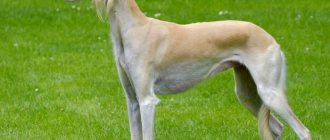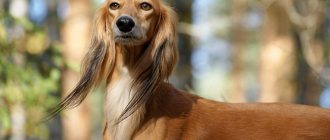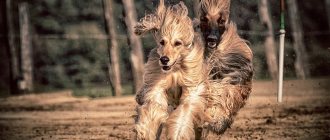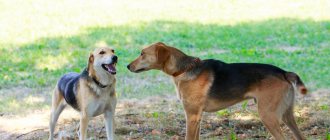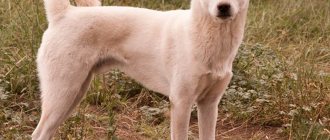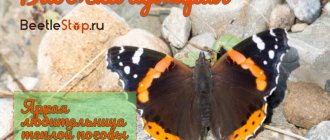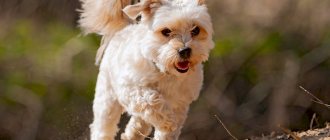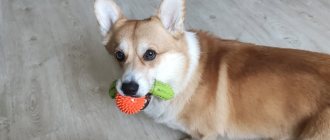* * * * * * * * * * * * * * *
At the National Saluki Specialty Show (Club Champion) on July 7, 2012 in Malakhovka under breed expert Niklas Eriksson (Qirmizi Saluki, Sweden), 30 Salukis were presented:
Azima Al Naqawa - exc1 in the National Club Champion class, CC, Reserve Best Bitch Aya Min Ayat Al Naqawa - exc2 in the National Club Champion class, CC Baqqam Al Naqawa - exc1 in the working class, CC, Best Male-5 => closed National Club Champion
Photo: E. Borzakovskaya, E. Paritchenko
At the Russian Coursing Championship in Sukhanovo (Moscow region) May 8, 2012:
Badaari-Badaari Al Naqawa - 1st among males - Champion of Russia in coursing Baqqam Al Naqawa - 4th among males Balasaan Al Naqawa - 1st among females - Champion of Russia in coursing (3rd year in a row!) Asheera Al Naqawa - 3rd among females
* * * * * * * * * * * * * * *
At the CAC show on March 31, 2012 in Rakvere (Estonia), expert Inga Siil (Estonia):
Azima Al Naqawa - BOS-1, CAC, BOB and BIG-1 - closed the Champion of Estonia and Baltics; Aya Min Ayat Al Naqawa - LS-3
* * * * * * * * * * * * * * *
At the CAC exhibition on February 18-19, 2012 in Valmiera (Latvia):
February 18 - Aya Min Ayat Al Naqawa - Best Man-1, CAC, BOB - finished Latvian Champion 19 February - Azima Al Naqawa - Best Man-2, CAC - finished Latvian Champion; Aya Min Ayat Al Naqawa - BOS-1, BOB and BIG-3
* * * * * * * * * * * * * * *
At the exhibition in memory of Sabaneev on January 28, 2012 in Moscow
IDAN ATIQ NASSIM (9.5 years) - Best Veteran - expert Frank Sabella (USA)
Photo: Al Nafiseh
* * * * * * * * * * * * * * *
At the exhibition on January 21-22, 2012 in Kaunas (Lithuania):
January 21 - Aya Min Ayat Al Naqawa - CAC, BOB and BIG-4 - Champion of Lithuania January 22 - Azima Al Naqawa - CAC, BOB and BIG-3 - Champion of Lithuania All results are here.
Photo: E. Karlova, Dog Show Travel, Vaida Dukauskienė
* * * * * * * * * * * * * * *
Care and maintenance
Saluki wool is easy to care for.
However, its length and density make it necessary to use overalls in winter. Closed ears require the owner's attention. It is necessary to frequently inspect the inside and clean it on time. This way you can avoid inflammation and also not miss the appearance of a tick. The eyes are examined weekly and, if necessary, washed with water or chamomile infusion.
The claws usually grind down on their own, because... This is an active dog, but it is advisable to monitor their condition monthly and trim them if necessary. Teeth need to be cleaned 1-2 times every 7 days. Overall, this is a healthy dog with no genetic problems.
Nutrition
Representatives of the breed have a thin build and rarely gain excess weight. Their activity allows them to burn a lot of calories, which maintains their natural shape. However, due to high energy costs, it is worth feeding a pet of this breed more often than others.
Typically, for adult dogs over 10 months old, feeding twice a day is sufficient; it is better to offer Salukis 3 meals. The frequency of feeding puppies is slightly different. Two-month-old babies are fed 5 times a day, after 2 months they reduce to 4, and by six months to 3.
Salukis are not prone to allergies, so they can be fed natural food. Preference should be given to lean meats, offal, vegetables, unsweetened fruits, and dairy products. Among porridges, it is better to choose rice or buckwheat. Twice a week you should include eggs and sea fish in your diet.
It is acceptable to use professional dry or wet food as the basis of nutrition. They have a balanced diet and sufficient amounts of vitamins. It is advisable to choose food of the premium or super-premium level and the “for active breeds” category.
Health
This breed is not artificially bred; a long period of natural selection has created a genetically healthy dog.
Vaccinations
Vaccinating your pet allows you to develop immunity to common dangerous diseases. 7 days before each procedure, it is necessary to give the animal an anti-helminth remedy. Babies are vaccinated twice, at 8 and 12 weeks, and adult dogs once a year.
Diseases that vaccination will protect against:
- plague;
- hepatitis;
- parovirus enteritis;
- rabies;
- coronavirus;
- parainfluenza;
- leptospirosis;
- trichophytosis.
After the vaccine is administered, the puppies are quarantined, because... immune defense has not yet developed. At this time, the owner must monitor the health of the pet; if the temperature rises, vomiting or other health problems, it is necessary to show the baby to the veterinarian. During the quarantine period, it is prohibited to walk your pet outside.
Diseases
Salukis have almost no health problems, especially of a genetic nature. Possible diseases include:
- Cardiomyopathy. A pathology that disrupts the normal contractility of the myocardium, as well as reducing the pumping function of the organ.
- Hypothyroidism. Suggests decreased production of thyroid hormones.
- Hemangiosarcoma. A malignant tumor that occurs inside blood vessels.
Walk
Saluki is a very active breed. They will not be able to stay at home without harming their health. They need to run and jump, so it is better to walk your pet in a park where there is enough space, or keep it in a country house with a large yard. Representatives of the breed will be interested in overcoming obstacles and accompanying the owner while rollerblading or cycling. Dogs pay almost no attention to toys, balls and frisbees.
When walking, it is worth taking into account the animal’s hunting instincts; after seeing the target, the dog may stop reacting to the owner. Therefore, it is better to keep your pet on a long leash, or let it go only in a fenced area. The fence should be high; a small Saluki can overcome it without any problems. At the request of the owner, you can involve the dog in training for hunting tasks, or engage them in coursing.
- The coat of representatives of the breed is not very long, except for the area of the ears, tail and feathers, so it does not cause any special problems in care.
- It needs to be combed weekly, and during shedding or after going outdoors, additionally treat it with a comb.
- If dirty, wipe the pet's paws and fur with a damp cloth. It is not recommended to bathe your dog too often, so as not to spoil the condition of the coat.
Estrus, mating, castration and sterilization
When the dog turns one year old, she has her first heat, but the bitch at this age is not yet sexually mature, so mating cannot be done. Experts advise not to breed her until she is two years old.
The period of estrus occurs twice a year, but there are exceptions. Sometimes there is no heat for 1-2 years. Males are ready to breed at one year of age.
Before mating, you need to prepare a comfortable nest for the animal. If the bitch lives in an apartment, she is isolated from the environment, ensuring peace and safety. Pregnancy lasts 2 months, but a deviation of 4-6 days is possible.
A dog gives birth naturally without human assistance, except in rare cases when the animal has any pathologies.
The process of giving birth to puppies is divided into 2 stages:
- Preparing for childbirth - during this period the bitch can be restless and may show aggression. She begins to move from one place to another, and sometimes moans.
- The next period is the appearance of puppies . Childbirth occurs on the side with pauses lasting from 15 minutes to 2 hours. The greatest interval is observed between the birth of the first and second puppy. Puppies are born deaf and blind. Only on day 9 do their eyes open.
If you do not plan to breed puppies, you will need to have your pet spayed or neutered. Otherwise, he will behave restless and aggressive.
Description and breed standard
Color: any colors and combinations are allowed, however, brindle color is extremely undesirable and points will be reduced for it at shows.
additional characteristics
The length of the body from the shoulders to the base of the tail should be approximately equal to the height at the withers, otherwise the dog will appear disproportionate.
The Saluki's coat is soft and silky. There are long-haired and short-haired Salukis; the former have a kind of “fluff” of wool on their legs and head (and sometimes on their chest). They also have fluffy ears.
The nose is black or liver brown, the eyes are very dark to hazelnut colored, large and oval.
Catering
Strong recommendations, akin to demands on the part of breeders, lie in the area of feeding gazelle dogs. Here, the opinions of foreign and domestic breeders agree that for Salukis, a diet of ready-made super-premium food for dogs leading an active lifestyle is preferable. Even puppies at one month of age begin to be accustomed to dry food soaked in bitch milk or water.
Important! The main thing is that the dog’s diet contains clean water in sufficient quantities. Clean and high-quality water is an integral part of a balanced diet for the Saluki.
Training and baiting
It is typical for Salukis to test their owner's strength before submitting. This is a very proud breed, and it will only obey its leader. Therefore, when she resists, you must be persistent, but not cruel. Saluki often plays a game of “who will out-stubborn whom.” Once she understands that you are a leader, there will be no problems with obedience.
You need to start socializing your dog immediately after the second vaccination and subsequent quarantine. Over the course of a month, try to show her to as many people as possible. Let her smell new smells and see unfamiliar places.
Saluki does not require baiting when hunting antelope, hares, foxes and other animals - natural instinct will work. This breed needs training if you suddenly decide to hunt a wolf with it, this is explained by the too close genetic connection between wolves and greyhounds.
If the Saluki, during 2-3 training sessions with an experienced hunter, cannot show healthy anger towards the wolf and capture it correctly, then the dog is not suitable for such a hunt.
Training
Raising a dog of any breed is a long and important stage. The type of relationship the owner builds with his four-legged friend immediately determines whether he will obey him, follow commands, etc.
From the first seconds of communication, you need to show the animal who you are for him. When getting to know him, it is important to restrain his joy as much as possible, so that the dog understands that you are serious, and in the future he will have no doubts about the need for obedience.
If a person shows weakness of spirit, the Saluki will never recognize him as the head of the house. In this case, the dog will become obstinate and overly stubborn. List of commands that should be taught to her:
- Place. A very important command that should be given when guests come to the house, especially those who are afraid of large dogs.
- Ew/no. It is recommended to give these commands by clicking with two fingers. The dog must know that there are rules that he cannot break, for example, he should not be allowed to chew shoes, bark for no reason, or approach a person who is afraid of him.
- Near. The command is given during a walk, especially if you walk the dog without a leash. You need to say “nearby, ugh” if, during a walk, she reacts to other animals.
Training the Saluki breed should include training in additional commands: fetch, sit, lie down, give a paw/give another. These dogs are not distinguished by their ingenuity, therefore, there is no need to count on the fact that they will improvise during training. Docile Salukis look cute and cuddly in the photo.
This animal must not be beaten. Physical abuse will never be forgiven to them. When training a dog, it is better to use the carrot method than the stick method. Every time he makes you happy, give him a treat, such as a piece of cheese. Positive reinforcement will help your pet quickly learn all the necessary commands.
The distrust that has arisen between the Saluki and its owner can complicate the training process. Remember, communication with this proud dog must be based on absolute trust. The animal must understand that in uncomfortable circumstances it can always rely on its owner to protect it.
The hunting greyhound especially needs long walks. You can take her to the river, run with her on a leash nearby, and do other physical activities together. Saluki breeders recommend training the breed to jump over fences. A dog that gets enough time will be happy and balanced.
Since this breed is quite capricious, performing the same command for 10 minutes can get boring. In this case, she will become stubborn. Therefore, in order to maintain the animal’s interest, you need to organize short, productive training sessions for it.
For example, several times a day (preferably at the same time) give him the commands “sit”, “give paw” and “lie down”. But it’s not worth saying “you can’t” out loud one more time.
Saluki diseases, symptoms and treatment
On average, a dog lives from 12 to 14 years, it is not susceptible to genetic diseases, but there are several typical diseases:
- Sensitivity to anesthesia. The Saluki requires less anesthesia than other dogs of the same weight due to its small body fat.
- Cardiomyopathy. Indicates changes in the heart muscle.
- Hypothyroidism. Low levels of thyroid hormones, which leads to infertility, obesity, and mental retardation.
At the same time, the owners say that the dog is very healthy and strong, and diseases rarely bother them. The American Canine Association says the disease affects no more than 5% of dogs.
Price
Today, you can buy a Saluki puppy from individual breeders and nurseries. Experienced dog breeders recommend the second option. The fact is that in nurseries, before purchasing a dog, they provide documentary guarantees regarding its health and condition.
Important! Be sure to pay attention to whether the puppy has all the necessary vaccinations. Information about them should be in his personal passport
The price of a Saluki breed, or rather a 2-month-old puppy from a nursery, is 30-55 thousand rubles. Purchasing an animal without a pedigree and relevant documents from private breeders will cost 25-30 thousand rubles. However, there are also more expensive offers, starting from 60 thousand rubles.
Regardless of where exactly you decide to purchase a puppy, in a nursery or from a breeder, pay attention to such parameters as its appearance and curiosity
Pros and cons of the breed
Saluki can boast certain advantages. But there are also disadvantages:
| Pros of the breed | Cons of the breed |
| Stunningly beautiful appearance | Excessive activity |
| Contact | Pride |
| Endurance | Waywardness |
| High efficiency | Regular long walks required |
| Stress resistance | Poor learning ability |
| Can live in the yard |
How and where to choose a puppy, price
To purchase a puppy, you should contact an experienced breeder or nursery. When choosing an animal, carefully read the pedigree and check compliance with the breed standard.
There are many nurseries in Russia where you can buy Salukis. Among the most popular, it is worth noting a few:
- Saluki / Shavati Kennel in Moscow breeds exclusively this breed. Here you can choose a worthy purebred pet.
- AL NAFISEKH is a private Moscow saluki nursery. Breeding work is underway. Here you can get detailed instructions regarding the care and maintenance of your purchased pet.
If the puppy fits all the parameters, then we can discuss the price. The average price for Persian greyhound puppies varies between 50,000-80,000 rubles.
If Saluki puppies are offered at reduced prices, then there is no guarantee that these animals are purebred.
Saluki is a very interesting breed, although keeping one is not always easy. However, everything is compensated by the pet’s devotion, energy and beauty. Therefore, dogs of this breed are valued not only in the East, but throughout the world.
Appearance of the Saluki
General impressions
In a sense, the breeding commissions welcome the existence of intrabreed types of Salukis. This means that Arabian greyhounds can be slightly different from each other without going beyond breed standards.
In the photo, the Saluki seems to be a graceful, but always hungry creature, as evidenced by its strongly sunken abdominal cavity. However, you shouldn’t treat it that way. Natural thinness is one of the unique traits included in the breed standard. Ideally, a greyhound should weigh from 17 to 30 kg with a height of 58-71 cm! Yes, individuals who have crossed the weight limit look healthier, but they are not allowed to enter exhibitions.
Head
The head of greyhounds is flat, elongated, slightly narrowed, but somewhat wider near the ears. The bridge of the nose is poorly defined.
The dog's teeth should be strong, even and white, the jaws should be massive and close into an even scissor bite.
The nose can be either black or flesh-colored.
The eyes are regular oval in shape, not protruding. The look is attentive and noble. The preferred eye color is the entire palette of brown shades.
Salukis have large ears that hang down. They are set high and fit tightly to the head. The upper part is densely covered with long, thin hair.
Torso
The physique is elegant, the muscles are practically not expressed, but the animal cannot be called fragile either. The back is strong, the lower back is slightly arched upward. The dog's thinness seems even more obvious thanks to the large chest with a well-shaped belly.
Forelegs
The front legs of the Saluki are perfectly straight. The muscular shoulders are strongly laid back, which creates the effect of ideal posture. The pasterns are flexible and slightly sloping.
Hind limbs
The back half of the dog’s body is noticeably more developed, because its role is to ensure fast running and jumping. The thighs and shins are large, well defined, the angles of the hock joints are moderate.
Movement
Large, but elegant paws are the hallmark of the breed. The two middle fingers are noticeably longer than the outer ones and protrude forward. They lie calmly, not spread out and not gathered into a ball, like in cats. This all allows them to move quickly, with smooth but intense thrusts from their hind limbs.
Wool
Most of the greyhound's body is covered with short, soft hair, smoothly turning into a lush fringe on the tail, paws, and ears. There are also smooth-haired Salukis. They look exactly the same, only without the fringes.
Color
The most common colors of Salukis are reddish, cream, and white. Also found are golden-red, grizzly, black and brown and tri-colored.
Brindle colors of the Saluki are undesirable, as they are considered a defect in the breed.
Size
The ideal height of a Saluki is 58-65 cm for a female, 65-71 cm for a male. This is quite a lot, if you take into account that the optimal weight of a Saluki is only 17-30 kg. This unusual ratio should not be misleading - this is a feature of the breed, not a defect. According to the proportions, the height of the Saluki allows the breed to be classified as large.
Kinds
Arab nomads developed several varieties of Saluki. In character they are not much different from each other. The main criterion for difference was the type of coat. One type of breed, the mountain one, has very delicate long hair, while the second, the desert type, on the contrary, has rough and short hair.
The second type of breed differs from the first in its small stature, 10-13 cm shorter.
Regardless of the Saluki type classification, it has a lean body with a clearly visible skeleton, especially on the belly. An inexperienced person can say about such dogs that they are hungry. This is not true. Thinness is a feature of many hound breeds. The exterior of this dog allows it to catch up with prey on almost any terrain, firmly holding it with its teeth until the owner arrives.
How to choose a puppy
When looking for the right Saluki puppy, you will have to follow the same principles as when choosing any other dog. In particular, communicate more with breeders, visiting kennels to assess the conditions of keeping greyhounds. If before the transaction the seller hints that if you are dissatisfied with the puppy, the animal will not be accepted back, this means that the person makes money from the dogs and he does not care what fate awaits his charges.
Be sure to meet the kids' parents. Don't limit yourself to reading pedigrees and assessing temperament characteristics, but also check the age of the litter's mother. If the bitch is less than 2 or more than 9 years old, it is pointless to count on healthy and promising offspring. You should not buy puppies from multidisciplinary nurseries whose owners simultaneously breed two or more breeds. If a breeder raises and exhibits for sale representatives of various breed groups, this characterizes him as an incompetent “breeder” engaged in the sale of low-quality “products”.
Choosing a puppy
The choice of a puppy must be approached with all responsibility, otherwise you can make a mistake and buy a dirty dog.
Where can I buy?
It is better to buy a puppy from a trusted nursery or contact a breeder. Before doing this, you need to read reviews about the supplier and ask for the dog's pedigree. The pet's appearance can be assessed both from photographs and during an examination, because... Hidden defects are difficult to spot in images.
Price
A purebred puppy sells for 50 to 80 thousand rubles, and if the purchase is made abroad, the cost can double. There are offers at a price of 15-35 thousand, but the purebred of such dogs is not guaranteed.
When purchasing a dog, you must request all documentation, including pedigree, information about the vaccine administered, etc.
Who should start one?
Persian Greyhound dogs need constant activity. They are not suitable for people who lead a moderate lifestyle or are away from home for a long time. The pet gets along well with children, but experts do not recommend families with small children to have a dog of this breed, because the animal may not allow anyone near the child.
Saluki food
To keep Salukis healthy, they need to be fed properly. Small puppies love dairy products, but are not averse to eating meat. As the dog grows up, the diet should be varied so that there is enough energy for training and walks. It is better to feed her at the same time. She quickly gets used to the feeding place and never throws food around.
At the very beginning, it is necessary to provide the same diet that the breeder had. For complete information, ask how the breeder prefers to feed older individuals. Be sure to remember that you need to feed the younger generation several times a day, unlike older dogs.
Saluki dogs are unpretentious in food, they love raw meat, but feeding it only will not improve your pet’s health. The following products should be gradually introduced into the puppy’s diet, starting from the age of two months:
- milk;
- raw or boiled egg;
- Porridge, preferably with meat broth;
- grated vegetables;
- meat, cut into small pieces.
If we talk about what to feed Saluki at a more mature age, then you can adhere to a similar diet, but it would be better to replace milk with cottage cheese or kefir. In general, Saluki puppies should be accustomed to fermented milk products from an early age. Because by the age of one, dogs have already developed their own eating habits, so they can simply ignore sour dairy products.
The following types of foods should be completely excluded from the diet of both young and adult dogs.
- Fried or smoked foods. They can cause basic digestive problems, subsequently gastritis or basic allergies.
- Sweets. It's not just chocolate and candy. These include cakes, gingerbread cookies and sweet biscuits.
- Fatty foods.
It goes without saying that the health of any dog is based primarily on what it eats.
An animal that is fed incorrectly and lacks mobility becomes overweight, begins to suffer from apathy, and exhibits lethargy in behavior. The dog gradually loses interest in everything; needless to say, the life expectancy of such a pet is sharply reduced.
Nutrition
Saluki puppies grow very quickly, therefore, their bones can only be helped to become strong through a properly organized diet. The basic rule is that it must be balanced. Since a puppy of any dog breed especially needs energy (due to increased activity), it should be fed 4 to 6 times a day. There are 2 “food” strategies:
- After the dog has stopped feeding on mother's milk, she is immediately given puppy food, which includes all the minerals necessary for growth. As she grows, her food also changes.
- Until 1 year, the dog eats dairy and meat products, and then feeds.
The second option is better. In addition to milk and raw meat, the puppy is also given vegetable soups, purees, baked goods and boiled eggs. Such a diet will saturate the dog’s body with all the vitamins it needs for full growth and development. However, regardless of the chosen strategy, Saluki will have to be excluded from the menu forever:
- Sweets: marshmallows, cookies, chocolate, marmalade, etc.
- Fats: butter.
- Semi-finished products: dumplings, pasties, etc.
Any errors in your pet’s diet can cause inflammation of its gastric mucosa and other health problems.
Saluki diseases
No severe hereditary genetic pathologies have been found in Persian greyhounds. Dogs are distinguished by excellent health and good immunity. But in very rare cases they get sick:
- Hypothyroidism. An endocrine disease associated with insufficient production of thyroid hormones. Symptoms will be: hair loss, sudden weight gain, lethargic and apathetic behavior, severe fatigue, drooling, etc. The quality of life decreases. Hormone therapy helps.
- Cardiomyopathy. A disease of the cardiovascular system, expressed in shortness of breath, drowsiness, dry cough, lethargy, weight loss, and seizures. It is fraught with unexpected death. Complete recovery is impossible; symptoms can be mitigated by taking medications.
Possible diseases and methods of treating them
Representatives of this breed do not have any specific genetic diseases. However, like many of man's four-legged friends, they are prone to illness. Regular errors in the Saluki menu can cause a disruption in the production of hormones in their body. This phenomenon is called “hypothyroidism”.
Remember, if your dog has suspicious symptoms, for example, difficulty breathing or apathy, you cannot help him yourself. Only a veterinarian can make an accurate diagnosis and begin treatment for your pet.
But, as practice shows, Salukis who eat well and regularly walk in the fresh air almost never get sick. But in order to prolong your pet’s life and improve its quality, you can give him a vitamin complex for dogs.
Description
Standard number: FCI No269
Group: greyhounds for hunting and racing.
Section: greyhounds with long hair or feathering.
The overall appearance of the Saluki is the embodiment of proportionality, grace and elegance. There are many varieties, but there are common standards for all representatives of the breed.
- Head. The skull has a highly elongated shape and is comparable in width to the body. The transition from the forehead to the muzzle is weakly expressed. The space between the ears is even, without bulges. The ears are mobile and set high, and when at rest they fit snugly to the head. There is long soft hair on the ears. The dog must have an even bite. The nose can be black or brown. The eyes are large, but not protruding.
- The neck is long, graceful, with well-developed muscles.
- The back is quite wide. Deep, large chest, toned stomach. The front of the body is much larger than the back.
- The tail should not be higher than the hock joint. It is set low and quite long. On the lower part there is a characteristic dewlap made of soft wool.
- The forelimbs are well laid back and have well-developed muscles. The shoulders and shoulder blades are approximately equal in length. Long, straight forearms flow into wide, powerful pasterns. On the hind limbs the hock joints are well defined and the articulations of the knee joints are almost not pronounced.
- The wool is smooth and soft. There are featherings on the legs, tail and throat. Rough or felted wool is considered a serious fault.
Main characteristics of an adult dog:
- weight – 14 – 27 kg;
- height – 60 – 70 cm;
- life expectancy is 10-14 years.
Any color is allowed, but brindle is considered undesirable. But at the same time, brindle color is not a defect and cannot be the reason for the disqualification of a pet in competitions, for example.
History of the breed
Salukis or Persian Greyhounds are considered one of the oldest breeds in the world, if not the oldest. They arose long before the advent of stud books and, perhaps, even writing. The origin of these dogs is still controversial among experts and historians. Opinions agree on only one thing: these beautiful dogs have existed on the planet for many thousands of years.
About seven thousand years ago, people were fully engaged in agriculture and settled in villages. At that time, dogs were already indoors, very different from the wolf and very similar to modern dingoes, New Guinea singing dogs and Pariah dogs of the Middle East. Their images are found on artifacts found in the areas of Ancient Egypt and Mesopotamia.
As small villages grew into empires and kingdoms, so did the noble class. One of the favorite pastimes of the Mesopotamian and Egyptian ruling classes was hunting. The terrain consisted of open spaces: meadows and deserts. The main prey at that time were gazelles, small antelopes, hares and birds. Hunting dogs in those regions had sharp eyesight and could see a target from a long distance. In addition, they were hardy and could carry on a long pursuit at high speed, leaving the fleet-footed wild animals almost no chance.
Hunting dogs in early Egyptian depictions are very similar to modern Ibicenco podencos and pharaoh dogs. Perhaps those dogs were known as tazy. Gradually, images of basins began to be replaced by drawings of a slightly different dog, surprisingly similar to modern Salukis. The first depictions of these Saluki-like dogs appear between 6000 and 7000 BC. A similar change can be seen in Sumerian (Mesopotamian) illustrations from the same period.
Throughout history, Egypt and Mesopotamia have had many trading partners and have been conquered multiple times by different peoples and empires. As a result, Persian greyhounds spread throughout the ancient world from Greece to China.
Among the conquerors were Arabs. The Muslim faith considers dogs to be unclean animals. According to most Islamic scriptures and traditions, Muslims cannot eat meat from animals killed by dogs. Also, dogs are not allowed into their owners' homes. However, an exception is made for Salukis.
Saluki, known in Arabic as El Khor or “The Noble One,” is considered a divine gift. Arabs can eat the meat of animals caught by the Persian greyhound, and dogs can enter the home of Muslims and sleep on the sacred carpets of the Arab nobility.
The Salukis left the Middle East along with European knights and were taken to the homeland of the conquerors as booty. A painting by Lucas Cranach, dating from the early sixteenth century, depicted a dog called the “Gazelle Dog.”
By 1800, Persian greyhounds finally established themselves in Europe. During these years, Britain was in full control of Egypt and most of the Arabian Peninsula. Many British officers, officials and their families were stationed in the region. Some of them began to acquire Salukis as pets and game animals. When they returned to England they brought their dogs with them. Salukis were originally known in English as “sluggies,” although recent genetic tests confirm that the two breeds rarely interbred.
The dogs brought to England did not gain popularity there until 1895. It was then that Florence Amherst saw Persian greyhounds during her journey along the Nile River and became fascinated by them. She adopted a pair of dogs from the Tahavi tribe of Lower Egypt, who would later start a kennel in England.
Florence Amherst would not only become the first recognized Saluki breeder in England, but would also publish the first standard in 1907, and in 1923 the Persian Greyhound would be officially recognized as a breed and given another name, “Gazelle Dog.” By 1927, Salukis were recognized in the United States. From that moment on, the Persian greyhound began to gain popularity, which it has not lost to this day.
Origin story
There is no exact information about the origin of the breed, so it is difficult to determine the date of its appearance. Scientists are of the opinion that animals were the first companions of humans and were bred in the Middle East. This is confirmed by the poems of Persian poets, written more than 5 thousand years ago, and the finds of artifacts with images of animals.
The name comes from the Arab settlement or Syrian city of Selekwiya.
In Muslim culture, the breed is considered pure, and the Bedouin tribes who use the dogs for hunting call them “a gift from heaven.” They worked on breeding animals, and the nomads dealt with issues of cleanliness. Dogs were honored and respected, so they were never sold to strangers.
Animals appeared on the European continent in the 19th century, when they were brought to Great Britain and called Persian Greyhounds. Soon they were shown at a major German exhibition, where they captivated representatives of different European countries with their grace and agility.
Purpose
For a long time, Persian greyhounds had the status of sacred dogs and were used to hunt hares, roe deer, wild donkeys and gazelles. Because of this, they were called gazelle greyhounds. The pet always had close contact with humans and even lived in the same tent with him. The Bedouins took him to the hunting ground on a camel.
Today, dogs are highly valued for their appearance, gracefulness and majesty. They are frequent participants in dog races, but are rarely shown at exhibitions, which is due to the small number of livestock. The cost of a puppy of this breed is quite high.
Features of character and behavior
Saluki with its entire appearance shows nobility of origin and self-esteem. Has a bright breed character.
Advantages
- Dogs of this species have an even and calm character. They do not provoke fights, get along with other dogs, but are not timid or shy.
- Salukis are attached to their owner, but do not try to bother him with their company.
- They are affectionate with the owner and family, love their company, but prefer the position of simply being nearby.
- Dogs calmly react to the appearance of strangers and rarely bark at them.
- They also coexist comfortably with children (except for the smallest ones).
- Representatives of the breed will not show aggression, even if the child handles them carelessly; they will rather simply leave.
Flaws
- Despite its devotion to its owner, the dog does not obey unquestioningly. During the pursuit, she may well ignore his commands. The same situation will arise if the dog is tired of training, is tired or is not interested.
- Due to its strong hunting instinct, the animal should only be walked on a leash.
- When prey of any kind is detected, the dog will begin to hunt, and given its speed of movement and ability to jump high, it will be difficult to catch up with the Saluki.
- Also, the dog will not tolerate the presence of small pets on its territory.
- Salukis do not accept rudeness, shouting, or swearing, even if they are not directed at her. The animal will be nervous and worried.
- You can also note the touchiness and vulnerability of such a pet, his love of freedom and stubbornness.
- The low sociability inherent in the breed does not allow them to become everyone’s favorite, because in relations with strangers they remain neutral.
Character
For those who do not like loud barking, the Saluki breed . She is not characterized by hyper-emotionality; she prefers to behave with restraint. The animal is always confident in itself, and if something from the surrounding world is not clear to it, it prefers to stay close to its owner.
A dog of this breed is very affectionate with each member of his family, but always chooses “person number one” for himself. Criteria for his selection: fortitude, moral stability, leadership. If you do not possess these qualities, then the Saluki will definitely not recognize you as its owner.
The breed is quite willful. She needs regular social contact with people. In his absence, he shows stubbornness and even resentment. For example, if an animal wanted to play, but you rudely refused it, it will silently leave and will not bother you about this for a long time. These dogs only show excessive agitation when hunting. At home they are less active.
As for their attitude towards children, it is more than welcoming. You can safely leave your dog alone with your baby without fear that it will harm him. These dogs are not prone to domestic aggression. A hound can lie next to a child for a long time, licking it and protecting it from others. A gentle attitude towards children is one of the main reasons for buying a dog of this breed these days.
The balanced nature of the animal makes it easier to train. You can have a dozen Salukis and leave them in the same area without any fear of them starting to fight. Dogs rarely physically harm each other without a clear reason.
A dog breeder who loves to be nice to his dog may be surprised at the relative coldness of the Saluki in communication. These self-confident dogs prefer to keep a distance from people, even from their owner. “Slicker” is definitely not what you would call a dog of this breed.
She is always reserved and focused. Excessive alertness manifests itself even in a relaxed state. When an animal is in a good mood, it will lie down next to a person and begin to rest. There can be no talk of any sudden movements on his part; the Saluki doesn’t need them.
The dog's behavior will change little when guests come to his house. He will never show aggression towards them, but he will not give them a warm welcome either. The dog will accompany the owner or will retire.
Advice! In order for the ice to break in the heart of the Saluki, and for her to become more gentle and open, it is recommended to spend a lot of time with her. Good intuition allows these animals to adapt to human moods and react based on it. Therefore, regular stroking and kind words will help make her more good-natured.
Even despite the coldness towards this dog, she, like all other representatives of her species, needs human love. The psychological climate in the family is very important for Salukis. She feels people's emotions very subtly and suffers if they are negative. The dog may not show it when watching your happiness, but believe me, at the same time he also feels positive emotions.
Additional Information
Royal dog of Egypt. The Egyptian nobility considered the breed a valuable and honorable companion, and dogs were known to be mummified in the manner of Egyptian pharaohs. The remains of Persian greyhounds have been found in tombs on the upper Nile.
Self-sufficient dog. Salukis are part of the greyhound group. When hunting, greyhounds rely only on their eyesight. They track prey with their eyes and catch it at lightning speed. People can't keep up with these fast dogs, so the dogs work alone. Because of this feature, the Saluki's character is extremely independent.
Deceptive vulnerability. Salukis look very fragile, graceful and weak. Few people know that these dogs are capable of reaching speeds of about 50-70 km per hour, and some individuals can run at a speed of 90 km per hour. The Saluki is considered one of the fastest dogs in long distance racing. In addition, the Persian Greyhound is famous for its endurance and ability to work in almost any climatic conditions.
Webbed feet. Salukis have special membranes between their toes that allow them to run freely on sticky sand.
Luxury lovers. Due to their fragile constitution and fine coat, Persian greyhounds prefer to lie on sofas, beds and loungers.
Subtle soul. Sensitive Salukis do not tolerate family discord well. Conflicts and quarrels can negatively affect the character of a susceptible dog.
Smoothies. Among the breed there are individuals without long decorative hair on the ears and tail. Such dogs are called “smooths,” which means “smooth” in English.
Nicknames for dogs: names for servants
Most people prefer to choose a short, sonorous name for their dog.
You will have to say your dog's name many times a day, and if it is too long, it will be tiring.
When choosing what to call slugs, you can be guided by two methods.
- The first and easiest: open the list of the most suitable names for this breed and choose the one that you like best.
- Second: choose an unusual name from other sources, for example, from mythology or literature, name the dog after your favorite celebrity, or come up with your own exclusive name.
There are many suitable names for servant girls:
- Addie,
- Nessie,
- Alma,
- Anda,
- Becky,
- Wendy,
- Gamma,
- Gina,
- Dina,
- Isis,
- Lada,
- Lorna
The following names are good for a boy's servant:
- Argon,
- Brandon,
- Kadel,
- Quint,
- Titus,
- Flor
Education and training
Persian greyhound training begins from the moment the dog is raised. As a rule, a puppy begins to be raised independently as soon as it crosses the threshold of a new home.
Each walk is a passage through a certain stage, where the puppy is shown how to go to the toilet outside and introduced to new commands. Every day, the material covered is reinforced by repeated repetition with treats and praise.
Dogs begin to prepare for serious dog shows during the same period. But as soon as the Saluki reaches 18 months of age, it is necessary to invite a professional handler. A new acquaintance always has a positive effect on the pet’s character. Moreover, a pro always selects an individual key through playing with an animal. And Salukis love communication so much!
